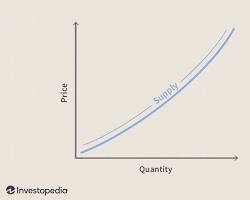1. The upward slope of the supply curve in economics is not arbitrary; it is a reflection of the law of supply. According to this principle, when the price of a good or service increases, the quantity supplied of that good also increases, assuming all other factors remain constant. This positive correlation between price and quantity supplied is the reason why the supply curve slopes upwards from left to right on a graph.
2. There are two main factors that contribute to this relationship. Firstly, the profit motive plays a significant role. Businesses aim to maximize their profits, and when the price of a good rises, it becomes more lucrative for producers to supply and sell that good. This profit incentive encourages producers to increase their output, leading to a rightward shift in the supply curve.
3. Secondly, increasing production costs also influence the upward slope of the supply curve. As production levels rise to meet higher demand at a higher price, it often becomes more expensive to produce each additional unit. For example, a bakery may need to purchase slightly more expensive ingredients or use less efficient equipment to produce more goods. This increasing marginal cost acts as a deterrent to unlimited production increases and contributes to the upward slope of the supply curve. It is important to note that the supply curve only reflects changes in price, assuming other factors such as production costs and technology remain constant. Any changes in these external factors can cause the entire supply curve to shift in different directions.
Multiple Choice Questions (MCQs) on Supply and Demand Curves
Instructions: Choose the best answer for each question.
- According to the law of supply, when the price of a good increases, what happens to the quantity supplied by producers? a) It stays the same. b) It decreases. c) It increases. d) It becomes unpredictable.
2.The upward slope of the supply curve indicates a relationship between:
a) Price and consumer happiness.
b) Price and quality of the good.
c) Price and quantity supplied.
d) Price and production time.
3. Which of the following factors is NOT assumed to be constant when analyzing the slope of the supply curve?
a) Price of the good.
b) Production technology.
c) Cost of inputs.
d) Quantity demanded.
4. What is the main difference between the supply curve and the demand curve?
a) They both slope upwards.
b) They are not related to price.
c) They show opposite relationships between price and quantity.
d) Supply curve reflects consumer preferences.
5. If the price of wheat falls, what would we expect to happen to the quantity of wheat supplied by farmers? (Assuming other factors remain constant)
a) It might increase, decrease, or stay the same.
b) It will definitely decrease.
c) It will definitely increase.
d) We need more information about consumer demand.
6. A bakery is facing rising flour prices. How might this affect the bakery's supply curve in the long run?
a) It will cause the supply curve to shift left. (Less supplied at each price)
b) It will cause the supply curve to shift right. (More supplied at each price)
c) It will not affect the slope of the supply curve.



